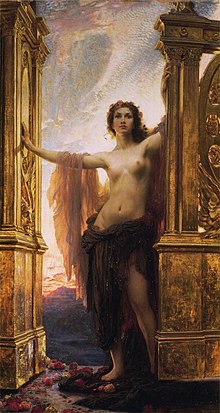
Back Eos Afrikaans Eos ALS إييوس Arabic Eos AST Eos Azerbaijani ائوس AZB Эос Bashkir Эас Byelorussian Еос Bulgarian এয়স Bengali/Bangla
| Eos | |
|---|---|
Personification of the Dawn | |
 The Gates of Dawn, by Herbert James Draper | |
| Ancient Greek | Ἠώς |
| Abode | Sky |
| Animals | Cicada, horse |
| Symbol | Saffron, cloak, roses, tiara |
| Color | Red, white, pink, gold, saffron |
| Mount | A chariot drawn by two horses |
| Genealogy | |
| Parents | Hyperion and Theia |
| Siblings | Helios and Selene |
| Consort | Astraeus, Orion, Cephalus, Cleitus, Ares, Tithonus |
| Children | The Anemoi (Boreas, Eurus, Notus and Zephyrus), the stars, Memnon, Emathion, and Astraea |
| Equivalents | |
| Etruscan | Thesan |
| Hindu | Ushas[1] |
| Indo-European | Hausōs |
| Roman | Aurora |
| Slavic | Zorya |
| Japanese | Ame-no-Uzume[2] |
| Nuristani | Disani[2] |
| Germanic | Ēostre |
| Part of a series on |
| Ancient Greek religion |
|---|
 |
In ancient Greek mythology and religion, Eos (/ˈiːɒs/; Ionic and Homeric Greek Ἠώς Ēṓs, Attic Ἕως Héōs, "dawn", pronounced [ɛːɔ̌ːs] or [héɔːs]; Aeolic Αὔως Aúōs, Doric Ἀώς Āṓs)[3] is the goddess and personification of the dawn, who rose each morning from her home at the edge of the river Oceanus to deliver light and disperse the night. In Greek tradition and poetry, she is characterized as a goddess with a great sexual appetite, who took numerous human lovers for her own satisfaction and bore them several children. Like her Roman counterpart Aurora and Rigvedic Ushas, Eos continues the name of an earlier Indo-European dawn goddess, Hausos. Eos, or her earlier Proto-Indo-European (PIE) ancestor, also shares several elements with the love goddess Aphrodite, perhaps signifying Eos's influence on her or otherwise a common origin for the two goddesses. In surviving tradition, Aphrodite is the culprit behind Eos' numerous love affairs, having cursed the goddess with insatiable lust for mortal men.
In Greek literature, Eos is presented as a daughter of the Titans Hyperion and Theia, the sister of the sun god Helios and the moon goddess Selene. In rarer traditions, she is the daughter of the Titan Pallas. Each day she drives her two-horse chariot, heralding the breaking of the new day and her brother's arrival. Thus, her most common epithet of the goddess in the Homeric epics is Rhododactylos, or "rosy-fingered", a reference to the sky's colours at dawn, and Erigeneia, "early-born". Although primarily associated with the dawn and early morning, sometimes Eos would accompany Helios for the entire duration of his journey, and thus she is even seen during dusk.
Eos fell in love with mortal men several times, and would abduct them in similar manner to how male gods did mortal women. Her most notable mortal lover is the Trojan prince Tithonus, for whom she ensured the gift of immortality, but not eternal youth, leading to him aging without dying for an eternity. In another story, she carried off the Athenian Cephalus against his will, but eventually let him go for he ardently wished to be returned to his wife, though not before she denigrated her to him, leading to the couple parting ways. Several other lovers and romances with both mortal men and gods were attributed to the goddess by various poets throughout the centuries.
Eos figures in many works of ancient literature and poetry, but despite her Proto-Indo-European origins, there is little evidence of Eos having received any cult or being the centre of worship during classical times.